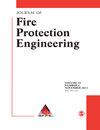Ignition: A Century of Research and an Assessment of Our Current Status
引用次数: 22
Abstract
Ignition has been systematically, scientifically studied for about a century now. But the development of knowledge in this area has been uneven, and while an advanced understanding has been reached in some areas, knowledge is scant in others. A review of the literature of the field indicates that the following are some of the notable areas where engineering calculation methods are poor or lacking: hot-surface ignition of liquids; ignition of liquid sprays or aerosols; ignition of solids from hot bodies (hot solids or liquids); ignition of solids by small flames; glowing ignition of solids, especially of lignocellulosic materials; almost all aspects of the ignition of dust clouds; and electrical fires. It is also noted that, despite a century's research, there have been very few theories developed in the ignition field that have engineering utility. The vast majority of theoretical development efforts have produced unwieldy computational models that would require a plethora of generally unavailable input d...点火:一个世纪的研究与现状评估
点火已经被系统地、科学地研究了大约一个世纪。但是,这一领域的知识发展并不平衡,虽然在某些领域已经达到了先进的理解,但在其他领域却缺乏知识。回顾该领域的文献表明,以下是一些值得注意的工程计算方法较差或缺乏的领域:液体热表面点火;液体喷雾剂或气溶胶的点火;从热物体(热固体或热液体)中点燃固体;燃烧:用小火焰点燃固体;燃烧:固体,尤指木质纤维素材料的发光燃烧;几乎各方面都有引燃尘埃云;还有电气火灾。值得注意的是,尽管经过了一个世纪的研究,在点火领域很少有具有工程实用性的理论。绝大多数理论发展工作产生了笨拙的计算模型,这将需要大量通常不可用的输入……
本文章由计算机程序翻译,如有差异,请以英文原文为准。
求助全文
约1分钟内获得全文
求助全文

 求助内容:
求助内容: 应助结果提醒方式:
应助结果提醒方式:


